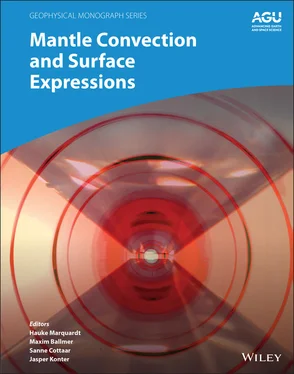Complementary constraints on compositional heterogeneity within the Earth’s mantle, and thus on mantle convection and material cycles between the surface and the mantle, are provided through the analysis of trace elements and isotope ratios in various basaltic rocks exposed on Earth’s surface. Takeshi Hanyu and Li‐Hui Chenreview our current understanding of chemical diversity in the mantle, as derived from the composition of surface basalts. They highlight some recent alternative models, and discuss implications for the deep cycling of volatile elements.
Part of the geochemical variation described in the chapter on isotopic data could result from selective sampling of the mantle through melting of different source lithologies as a function of pressure and temperature. Ananya Mallik et al.examine the role of melting a mantle assemblage of different lithologies, melt‐rock reaction, and magma differentiation for the genesis of mid‐ocean ridge basalts (MORB), ocean island basalts (OIB), and volcanic arcs.
Diamonds provide complementary information on the composition and mineralogy of the deep mantle. Tiny mineral and glass inclusions in diamonds directly sample the petrology of the deep Earth, providing constraints on its chemistry and mineralogy beyond those derived through the interpretation of geophysical observations and geochemical analyses of surface volcanic rocks. Evan Smith and Fabrizio Nestolasummarize the progress in this field during the last decade, focusing on findings of major relevance to our understanding of deep Earth material and volatile cycles.
The D" layer in the lowermost mantle is characterized by several unique geophysical features that are distinct from the bulk of the lower mantle, including ultralow velocity zones, ULVZ. Jennifer Jackson and Christine Thomascontribute a review of seismic observables and their possible interpretations based on mineral‐physics data, and present a case study focusing on the deep mantle below the Bering Sea and Alaska.
Paula Koelemeijerdiscusses the challenges involved in determining the topography of the core–mantle boundary (CMB) from geodynamic and seismic constraints. She highlights the close correlation with the density structure in the lowermost mantle and its association with the observed large low shear velocity provinces (LLSVP) as are observed under Africa and the Pacific. She concludes that more work is needed to better constrain CMB topography, which would be a critical step toward understanding the nature of LLSVPs and their relationship to mantle dynamics.
Part II: Material Transport Across the Mantle: Geophysical Observations and Geodynamic Predictions
When combined with mineral physics constraints, observations of seismic anisotropy in Earth’s mantle can be used to infer mantle flow patterns and understand material transport through the mantle. Thorsten Becker and Sergei Lebedevsummarize seismic anisotropy observations made in the upper mantle and discuss their relation to laboratory measurements. It is shown that regional convection patterns can be resolved using anisotropy observations, but uncertainties remain and systematic relationships need to be further refined and established.
An essential regional component of mantle convection is the subduction and deep cycling of oceanic lithosphere. Indeed, the sinking of subducted slabs through the mantle is a key driver of mantle circulation and plate tectonics. Zhouchuan Huang and Dapeng Zhaodiscuss the analysis of seismic anisotropy in subduction zone settings that is used to infer deformation and flow patterns around subducting slabs in the upper mantle.
Subducted oceanic crust often descends deep into the mantle, commonly reaching the core–mantle boundary. Understanding the fate of subducted material and its chemical interaction with the surrounding mantle is pivotal to our understanding of deep Earth material cycles, the interpretation of geophysical heterogeneity, and the diversity of geochemical signatures found in surface rocks. Mingming Lireviews our understanding of the distribution, physical behavior and chemical interaction of subducted oceanic crust in the deep mantle that emerges by integrating evidence from different disciplines.
In regions where subducting slabs reach the core‐mantle boundary, they may cause deformation strong enough to induce seismic anisotropy, in a similar way as discussed above for the upper mantle. Andy Nowacki and Sanne Cottaarexplore the potential and limitations of multidisciplinary approaches to infer deep mantle flow from recent observations of lowermost mantle seismic anisotropy.
While the downwelling limbs of mantle convection are commonly observed in seismic images, at least in some cases from the surface to the core–mantle boundary (see above), the nature of upwellings remains more under‐resolved and uncertain. However, while their existence has been highly debated for a long time, researchers now converge towards a consensus in terms of the sheer existence and nature of plume‐like upwellings. Jeroen Ritsema et al.report on the challenges involved in imaging mantle plumes by seismic methods. They conclude that the deployment of seismic receivers on the ocean floors would lead to a significant advancement in our ability to image the interior of our planet in general, and mantle plumes in particular.
Part III: Surface Expressions: Mantle Controls on Planetary Evolution and Habitability
An important surface expression of mantle dynamics is dynamic topography. Dynamic topography arises directly from mantle flow and the related stresses at the base of the lithosphere. It thus contains information about the density structure of the mantle. The study of dynamic topography can potentially provide a picture of Earth’s mantle flow and structure through time, when coupled with geological constraints of subsidence and uplift. Mark Hoggard et al.review the progress made in quantifying dynamic topography, summarize the inherent limitations, and point out future research directions.
Trond Torsvik et al.bring together the main topics discussed in this book in a single chapter. They discuss the role of mantle upwellings (plumes) and downwellings (slabs) on atmospheric evolution and climate. Plume heads may rise from the margins of LLSVPs and sustain flood‐basalt volcanism, outgassing and silicate weathering at the surface. Slab subduction and related arc volcanism, in turn, control the ingassing of atmospheric species, including greenhouse gases. Together, these key ingredients of mantle convection stabilize Earth’s long‐term atmospheric conditions, climate, and habitability.
While Earth’s surface is currently reshaped by plate tectonic processes that are intimately linked to mantle convection, other terrestrial bodies in the solar system display a stagnant lid that does not participate in underlying mantle convection. In other words, the surfaces of these planets consist of just one single plate with very restricted surface deformation. Nicola Tosi and Sebastiano Padovanpresent key processes and observations to understand mantle convection in the stagnant‐lid regime, which is much more common in our solar system, and most probably throughout the universe, than the plate‐tectonic regime. The comparison of mantle convection styles in both these regimes leads to a more coherent picture of planetary interior dynamics and evolution.
Hauke Marquardt University of Oxford, UK Maxim Ballmer University College London, UK Sanne Cottaar University of Cambridge, UK Jasper Konter University of Hawaii at Mānoa, USA
Читать дальше












